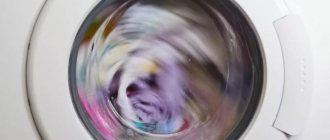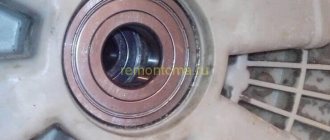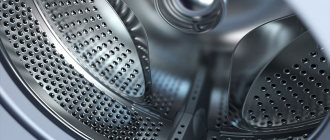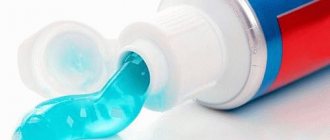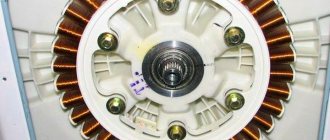An automatic washing machine is one of the most frequently used household devices in the home. Constant washing leads to the appearance of excess moisture in the drum, the development of mold and bacteria. The result is a deterioration in the quality of washing and premature failure of parts. Careful adherence to all operating rules does not always prevent problems. The built-in function for cleaning the drum in the machine from LG will help you easily remove dirt and extend the life of the expensive unit.
Eco drum cleaning function in a Samsung washing machine
Korean proprietary development - ECO BUBBLE technology. In combination with the original design of the drum in the form of a honeycomb, it allows you to beat the detergent into bubbles saturated with oxygen and improve the quality of washing. Over time, the recesses in the honeycombs can become clogged with particles of dirt or threads.
A special function is provided for removing debris - it is indicated on the machine panel as “Eco drum cleaning”. The latest models of Samsung washing machines are equipped with an alert system. At this moment, the image of a reel with an asterisk will light up on the panel.
The appearance of a reminder does not mean that there are serious problems with the washing machine. The regularity of cleaning depends on the intensity of use of the machine. Typically, the auto notification lights up once a month and if the owner has not used the function, the icon will reappear after two wash cycles.
Scope of application of the cleaning function
Mold and putrefactive bacteria, if not removed from the machine, grow in a humid environment, which leads to an unpleasant odor. Bright things fade after washing, becoming dull. The automatic cleaning function allows you to maintain hygiene inside the drum at a high level, wash more often at low temperatures, saving energy.
How does it work?
After turning on the function, the washing machine runs idle at a water temperature of 70 C, which allows you to destroy bacteria and mold accumulated in the drum. The temperature is automatically set by the program itself, and the user cannot change it.
The entire program cycle takes place in 90 minutes at high engine speeds. The function works without user intervention; only the “Delay” button is available for control.
How to enable the feature?
Before using the function, you should check the cleanliness of the filter and drain hose - if clogged, the program will work less effectively.
Attention! The self-cleaning function cannot be turned on if there is laundry inside the device - this can lead to breakdown of the device and damage to things.
- Open the hatch and inspect the space for forgotten things or stuck garbage
- Close the hatch
- Turn on the machine's power
- Scroll the washing mode selection wheel and stop it at o
- Press start/pause button
Advice! Do not use commercially available chemicals to clean the machine. Residue from cleaning products that remains on the drum will impair the performance of the unit. It is allowed to use only products recommended by the manufacturer.
Peculiarities
The South Korean company LG first released washing machines with the function of steaming clothes in 2005, however, such units appeared on the Russian market later, due to which our consumers still do not have a very good idea of the difference between conventional washing equipment and devices equipped with the True function Steam.
The fact is that in an ordinary washing machine, which does not include this innovative technology, the temperature of the water in the drum is not the same, and allergens have the opportunity to “hide” in its colder part. In order to heat the laundry evenly, it is necessary to ensure a constant temperature of 60 degrees for 30 minutes, which becomes possible when using an LG washing machine with a steam function.
Tiny organic and inorganic particles penetrate deep into the fibers of the fabric, which complicates the process of washing clothes, since it is quite difficult for washing powder to reach such stubborn contaminants. A special steam washing mode comes to the rescue, during which hot steam freely penetrates between the fibers of the fabric, destroying foreign particles, destroying allergens, bacteria and foreign odors.
Let us list the main advantages of LG washing machines with steam function.
- Improved washing quality by 20% compared to conventional washing machines.
- Economical operation - this result is achieved due to the fact that steam generation requires several times less water than for conventional washing, in addition, the operating time of the washing machine is significantly reduced, which also reduces energy consumption.
- The effectiveness of washing the thinnest fabrics - it has been noted that the True Steam function is best suited for delicate washing, since treating laundry with hot steam is similar to boiling it, and in addition, the fabrics do not fade or become deformed.
- This option completely replaces pre-soaking the laundry, while being much more effective. Linen treated with hot steam washes much better.
- The ability to destroy microscopic mites living in different types of tissue. You just need to turn on the “steam effect” option, which will destroy these harmful inhabitants and disinfect your laundry without washing with water.
- Treating linen and clothing with hot steam removes bacteria and allergens from items.
- This function helps to refresh and free laundry from small wrinkles, perfectly preparing items for their subsequent ironing.
Some users also mention the disadvantages of such washing machines.
- The True Steam function is unavailable for some laundry washing modes.
- Not all types of stains can be removed using this technology.
- This function does not replace ironing, but only makes it easier (however, no instructions for such machines say otherwise).
- After steam treatment, laundry remains slightly damp and requires additional drying. However, some LG brand washing machines with steam treatment also have a laundry drying function, which, of course, affects the price of such units.
- Quite a high price for LG machines with True Steam capability. However, many of their owners note that the game is worth the candle - high-quality washing, clean laundry free of bacteria and allergens, and economical operation fully pay for the additional costs of purchasing such a washing machine.
Thus, we can conclude that such washing machines have much more positive aspects compared to negative ones. Such smart cars are in great demand among buyers both in our country and abroad.
Why is a “dirty” drum dangerous?
Scale and mold, as we have already found out, are the main “enemies” of the automatic machine, which must be actively combated. It is the drum that is the most vulnerable part of the SMA in terms of the deposition of such formations on it.
The moisture and heat that are constantly present in it create ideal conditions for the proliferation of harmful microorganisms inside the device and the further appearance of mold. An unpleasant odor on washed clothes is the first sign that the washing machine needs disinfection. This situation is not dangerous for the washing machine itself, but sooner or later it will affect the health of its owners in the form of an allergic reaction.
A potential threat to SMA components comes from scale. Its formation is facilitated by the use of water with a high content of mineral salts. Limescale, affecting the main functional components of the SMA, reduces the efficiency of its operation, and therefore the quality of the wash itself. The problem will be solved by simply cleaning the device with special cleaners or substances that can remove harmful formations.
How to wash
To ensure that your washing machine does not break down due to frequent use, you need to constantly keep it clean.
Important! Keeping it clean means regular general cleaning (the entire device must be cleaned, from the outer case to the internal elements).
Drum
The best place to start when cleaning is the drum. It is in it that after each wash the remains of dirty liquid, fat deposits, plaque particles, etc. remain.
In addition, black spots may appear in the folds of the rubber cuff, indicating the appearance of mold. And the musty smell coming from the depths of the machine also does not make its use pleasant.
Drum cleaning:
- The easiest way to solve the problem is with an unpleasant odor. To do this, you need to run the machine in idle mode and add citric acid or suitable disinfectant compounds inside.
- Next, you should move on to cleaning the rubber seal. You'll have to clean it by hand, so be prepared. To begin, spread the folds apart, and then wash the entire circumference of the cuff using a clean dishwashing sponge soaked in warm soapy water. Do everything carefully so as not to tear the seal.
- At the end, you need to wipe the gum DRY, since stagnant moisture can again lead to the appearance of plaque and odor.
- If you see that mold spots have appeared on the cuff, then you need to prepare a solution of copper sulfate or baking soda paste (water and baking soda powder mixed in equal parts). One of the two indicated preparations should be used to treat the areas affected by mold and leave the product for a couple of hours.
- Wipe everything thoroughly with a sponge and run the machine in long-term wash mode.
heating element
Important! The heating element is the most important element of the washing machine, which, if not properly maintained, can fail at the most inopportune moment.
The tubular electric heater is in direct contact with running water, and therefore, after each use of the washing machine, scale will accumulate on it (it is salt deposits of magnesium and calcium).
If you do not have a water softening filter in your drain, then when washing you should also add special water softening agents to the washing powder (for example, the much-advertised Calgon). It is also worth doing monthly maintenance to avoid breakdowns.
Method number 1:
- The easiest way to deal with lime deposits is with tribasic carboxylic acid or regular citric acid. Pour the acid into the powder tray, and then turn on the washing machine in any high-temperature wash cycle. The acid will corrode plaque and limestone and clean the heating element and drum steel from scale.
- Calculate the amount of acid powder based on the degree of contamination of the machine, as well as its capacity. Typically, for every kilogram of filler there should be 25-30 g of acid.
- If you haven’t cleaned the machine for a long time, then you can do the following trick: pour the acid powder into the powder tray, turn on the machine for a long wash cycle at 90 degrees, and then turn off the unit from the network in the middle of the process. Leave the device overnight and run the wash again in the morning.
- This experiment should be carried out no more than 4 times a year. After each such procedure, you need to inspect the drain hose and cuff; large particles of limescale may accumulate there; they will need to be removed manually.
Method number 2:
- It is best to use specialized preparations for cleaning. They have one significant advantage over all folk remedies combined - they are developed taking into account the design features of the unit, and therefore their composition will never harm any element during cleaning.
- Remember that most products can protect the machine from the appearance of plaque, but they do not guarantee getting rid of existing scale. Most often, such products simply soften the water, which significantly reduces the amount of salts in it (for example, like Calgon).
- These products should be used during washing. Simply add them to the powder tray (along with the powder) or directly into the drum, and then start the wash.
Rubber compressor
So, you have started the machine in self-cleaning mode at the drum cleaning stage. When the procedure is completed, you can begin cleaning the rubber seal.
The rubber seal is an ideal zone for the growth of various fungi, mold and other microorganisms that harm humans and the device itself:
- You can clean the cuff using almost any cleaning product. For example, you can use Pemolux or baking soda (if you prefer folk remedies).
- If there is too much mold, and even an unpleasant odor is added to all the existing contaminants, then it is better to choose Komet, White (as a last resort), Domestos or Utenok. These tools are much more powerful. They can not only clean the gum from pockets of mold, but also disinfect it.
- Apply a small amount of the desired cleaning agent to a damp sponge or rag (if you are working with bleach, do not forget about gloves and safety glasses), then pull the cuff towards you and wash the metal elements of the case.
- In the same way, run the cleaning agent over the elastic itself.
- Since most of the dirt remains at the bottom of the hatch, its entire circumference should be cleaned.
- After all procedures, go over the cuff with a damp, clean cloth.
Drain pump
After cleaning the drum, cuff and heating element, you can proceed to cleaning the drain pump (drain filter). If you have already seriously neglected the condition of this element, then do not be surprised when one fine day the machine simply stops draining water through it.
In order to avoid a flood, you need to regularly clean the pump from dirt and lime deposits:
- You need to take a container of suitable height (for example, a baking tray from the oven), a towel or a well-absorbent rag, a flat screwdriver or any other flat tool.
- Now open access to the filter (most often the entrance is located at the bottom of the machine). Before unscrewing the lid, cover the floor with a towel or rag, and place a container under the drain to collect water (just in case of a fire).
- Unscrew the filter cap counterclockwise and remove all debris and accumulated dirt from the pump.
- Next, wipe the hole with a clean damp cloth, close it and install the panel in its rightful place.
Water inlet filter
In addition to the drain filter, the washing machine also has a water inlet filter. It also becomes covered with rust and sand over time. When the inlet hose filter becomes unusable, the machine refuses to wash and shows that it is impossible to draw clean water.
How to clean the filter:
- First, you need to shut off the access of cold water to the washing machine.
- Next, turn the machine around to see access to its rear panel. On the right, in the upper half of the housing, you will see the inlet hose.
- Unscrew the nut counterclockwise and look inside the opened hole. Did you see a small filter with a mesh? This is exactly what you have to get out with the help of pliers or pliers.
- Using a toothbrush, rinse the filter under running water, then return it to its place and screw the inlet hose back clockwise.
- Run cold water.
Powder tray
Advice! Ideally, the tray for powder and other laundry preparations should be washed after each use of the washing machine. This will help prevent the remnants of powders, gels and other products from accumulating in the grooves and leaving an unpleasant odor and residue on the surface.
If you do not regularly clean the tray of powder, you will have to work hard to clean everything at once.
You will have a hard time, because the container has many small grooves and other hard-to-reach elements that are difficult to get to with a regular rag or sponge:
- To begin with, you can thoroughly spray the compartment with a spray cleaner and leave it to soak for a couple of hours.
- Next, you can start cleaning the tray itself, which is covered with rust, plaque and residues of cleaning products. You can use household chemicals for this (like Pemolux) or folk remedies (a mixture of soda, hot water and vinegar).
- Treat the container with the chosen product and leave it to soak for another half hour.
- After this, go over the container with a sponge or toothbrush, removing any remaining cleaning products.
- Wipe the tray dry and place it in its usual place.
Source: https://ktexnika.ru/uborka/ochistka-barabana-v-stiralnoj-mashine-lg.html
Why does the powder receptacle become dirty?
The powder receptacle of your LG washing machine can also become dirty. Dust gets into it, incompletely washed residues of detergents and air conditioner may linger in it, and water leaves a limescale deposit.
The most convenient way to put the cuvette in order is to take it out of the machine (read how to do this here). For proper cleaning, you can use a small brush. For example, an old toothbrush.
It is advisable to wash not only the tray, but also the opening into which it is inserted. To do this, it is convenient to use a damp sponge with citric acid powder applied to it. After wiping, the surfaces should be rinsed with water.
How to prevent scale formation
First of all, you should install filters at the water inlet from the water supply system. It's not cheap, but in the end it's still cheaper than repairing or even buying a new washing machine. In addition, you should not be lazy and properly prepare dirty laundry for washing:
- Always check your pockets and remove any small items left in them.
- Clean things from dried dirt, sand, blades of grass and other debris.
- Shake off dirty laundry before washing it.
- Use special bags for washing. this way things will be more intact and the machine will stay clean longer.
And of course, periodically you need to run the machine idle with the cleaning composition at the highest temperature. Here's how to do it yourself correctly.
Is it available on all models?
Unfortunately, not all LG washing machine models are equipped with a drum cleaning function. The button with “*” located on the control panel will help you understand whether a particular washing machine has such a program.
The most popular models of LG washing machines equipped with a self-cleaning mode:
- LG F-1296ND3 (due to the removable cover, the washing machine can be built in).
- LG F-10B8ND (in addition to the drum cleaning function, it is equipped with a Smart Diagnosis system and protection against leaks).
- LG F1048ND (narrow model equipped with nine washing modes and twenty-two additional options).
- LG F1280NDS (narrow model equipped with a steam function and a hypoallergenic washing mode).
What's better?
When choosing between using the automatic cleaning mode and alternative (improvised, store-bought) means, you need to analyze the pros and cons of each method.
So, using improvised products or store-bought compounds will help restore cleanliness and freshness to the walls of the drum, regardless of whether the washing machine is equipped with a self-cleaning mode or not.
The means at hand (soda, citric acid) are absolutely harmless to health and are as affordable as possible. The only negative that may affect the choice is that using an excessive amount of cleaning agent can destroy the rubber seal around the hatch and dull the gloss of the drum walls.
The “self-cleaning” function allows you to quickly, efficiently and, most importantly, safely clean the inner surface of the drum without human intervention. Among the disadvantages, it is worth noting the high energy consumption (the “self-cleaning” program takes place at the highest possible temperatures for a long time).
Some useful tips and operating rules
Sometimes water leaks when cleaning is completed. In most cases, the cause of the malfunction is a poorly tightened filter. In this case, you need to unscrew it again and carefully put it back in place. It is also possible that the gasket was too worn.
It is useful to take measures to prevent blockages. To do this, it is recommended to do the following:
- Filters must be cleaned on a regular basis. In this case, dirt will accumulate in them to a minimum extent.
- You need to inspect the clothes being washed and the water for small objects that could clog the machine drain. It is necessary to check the pockets and how tightly the buttons are sewn.
- You need to choose the best quality laundry powder and conditioner available to use.
- If you need to wash clothes that have small parts (for example, beads), it is recommended to do this in a special bag.
Proper care of equipment will extend the life of the washing machine.
Source: https://teh-int.ru/dom/kak-ochistit-baraban-stiralnoj-mashiny-lg.html
Pros and cons of cleaning with citric acid
The properties of citric acid are determined by its chemical structure. This substance was not invented specifically for cleaning washing machines, so its effect on equipment parts has both positive and negative sides.
Positive aspects of the method
Without cleaning the scale in the SM, you can expect, at a minimum, burnout and the need to replace the heating element. Therefore, there is no need to delay the cleaning procedure. The method for removing deposits should allow anyone without experience to carry out the procedure.
If you decide to regularly clean your SM with citric acid, you can buy a large volume of it at once. It will be cheaper and less troublesome
The use of citric acid to eliminate accumulated insoluble salts meets this requirement due to a number of advantages:
- Availability and low cost. Citric acid in the required quantity can be bought in any store for several tens of rubles.
- Simplicity. Even an untrained person can carry out the cleaning procedure.
- Efficiency. 100 g of citric acid will dissolve up to 80 g of scale.
- Safety. Both citric acid and calcium citrate formed after dissolving scale are harmless to health.
These positive aspects of LC make it the drug of choice in the fight against scale. There is no point in buying expensive special products for cleaning SM if they provide a similar effect.
Citric acid is used both in caring for the internal and external parts of the washing machine. The advantage of this folk remedy is that using lemon juice can effectively clean surfaces that are inaccessible to the user.
Confirmation of the effectiveness of removing accumulations with citric acid is demonstrated in the video:
Negative effects of citric acid
There are legends about the negative effect of citric acid on internal parts when cleaning a washing machine. Numerous arguments are given against this method, but little evidence is provided.
The theoretical claims of people regarding cleaning SM with citric acid are:
- The formation of salts that remain in the washing machine and can clog the drain.
- The acid corrodes the metal components of the heating element.
- Rubber seals soften and may crack.
- After cleaning, things develop a specific smell.
To remove scale from the SM, a 1% solution of citric acid is used.
For comparison, a 10% solution of aggressive hydrochloric acid is used to clean water heating boilers from deposits. And even multiple treatments with such a strong agent do not affect the operation of the equipment. And rubber is generally resistant to short-term exposure to weak acids.
The problem will arise if crystals or citric acid solution remain in the pocket of the rubber seal that seals the door. In other cases, the negative effect of citric acid on the insides of the washing machine is a myth.
Holes in the cuff from citric acid do not appear immediately, but only after multiple descaling sessions without following basic rules
The salts formed during descaling, together with the remaining lacquer, are completely removed by subsequent two or three rinses, leaving neither odor nor sediment.
Are all the disadvantages of citric acid really far-fetched? No, descaling has one more drawback, but it is common to all cleaning products.
Insoluble salts can accumulate at water leaks, temporarily closing the hole and eliminating the problem. After cleaning the washing machine, the leak may appear again. The described problem is not caused by citric acid or other means, but you should be aware of the possibility of its occurrence.
The consequences of using LC for cleaning SM are presented in the video:
Use of household chemicals
You can use various means to solve the cleaning problem. Usually this is “Belizna” and other chlorine bleaches, or professional preparations. Chlorine-based products do an excellent job of removing contaminants of any origin. But it is worth remembering that chlorine also negatively affects any parts made of rubber. The substances also have a negative impact on human health.
Tips for carrying out complex cleanings
Mold, unpleasant odors and dirt are problems that every equipment owner faces. You should regularly maintain the cleanliness of the elements located inside the device.
Washing the drum
Combining disinfectants with idle circulation is one possible solution to this problem. Regular citric acid can also be used. It is recommended to clean the rubber band only by hand.
The simplest processing option requires the following requirements:
- Carefully push the folds apart.
- Wash the cuff around the circumference. We use a sponge, soap, warm water.
- Wipe the surface of the part dry.
A solution of copper sulfate is used if the owner notices the appearance of mold spots. Another acceptable remedy is to prepare a cleaning paste that includes water and baking soda in equal proportions.
The purpose of the composition is to process not only rubber bands, but also the entire drum. The machines are kept in this position for two hours, then we wipe them with a sponge and start the long-term wash mode.
Working with filters and drainage hoses
An unpleasant odor is often caused by dirt particles that remain virtually invisible to the human eye. This is especially true for debris that could not be removed from clothing in time before being placed inside.
It is recommended to clean drain filters at least once every three months. If the exploitation is active, then the work is carried out more often.
The operation involves removing the protective panel and a small container into which water flows. You can protect the floor with a cloth. The filter is unscrewed using counterclockwise movements.
Then there is washing, with water under high pressure, the accumulated debris is removed from the hole. When cleaning, the hose is simply disconnected from the parts to which it previously fits.
The design and features of the part depend on which specific model of equipment is used by a particular buyer. If there are vertical models, the hose can only be reached using the side cover.
Source: https://stiralkainfo.ru/ekspluataciya/funkciya-ochistki-barabana-v-stiralnoj-mashine-lg.html
Special means
Frisch Aktiv is a specialized cleaning product developed by specialists from Germany. Thanks to modern technologies, an option has emerged that can be used for cleaning without much harm, even if the procedure is carried out weekly. This solution is effective, and various parts located inside the device do not suffer from such effects.
How to use chemicals?
For a safe and effective cleansing process, it is important to know in advance how to properly use a particular product. “Whiteness”, citric acid or vinegar suggest that the following instructions will help:
- First, the product is poured into the drum.
- We set the standard washing program lasting 1 hour. Temperature regime – not lower than 60 degrees.
- After the wash is completed, the double rinse starts.
- When the device is completed, the machine is left open to dry everything.
As for the Frisch Activ development, its application will be slightly different:
- Half of the cap is placed inside the cuvette.
- The other half is poured directly into the drum.
- At high temperatures, a cold wash starts.
- The scale should soak in the water, along with the product.
- Then the rinse mode starts.
The drum can be called an indicator, which always shows how dirty other parts are. If scale accumulates on the walls of the drum, it means that it is present in large quantities on other surfaces. Therefore, cleaning can be carried out for other parts, including tanks and pulleys, heating elements, rubber hatch cuffs, and drain filters.
If you're afraid of making a mistake
Operating an automatic machine is not at all as complicated as it might seem at first glance. The main thing is to follow the basic recommendations for using the washing machine. Basic tips for users:
- do not be lazy to read the instructions for the equipment, even if you have previously used a machine of a different model, and it would seem that you know everything about automatic washing;
- measure the hardness level of tap water and select suitable detergents that protect the washing machine elements from scale formation;
- Do not change the washing parameters if the machine has already filled with water and started working. Otherwise, problems with the electronics may occur;
- do not overload the machine, at the same time do not “drive” the machine with an almost empty drum;
- at the end of washing, wipe the unit, leave the hatch door open;
- Do not place heavy objects on the top cover of the SMA.
Now you know how to start washing on LG machines. If you follow the basic recommendations for using the equipment, the automatic machine will delight you with high quality washing for many years.
LG program table: description and symbols
The washing modes in the LG washing machine have their own names. There are practically no symbols on the control panel; the manufacturer has signed each program.
For a breakdown of programs and modes, see the table below.
| Name | Meaning | For what type of fabric | The approximate time |
| Cotton | Thanks to the multidirectional movements of the drum, laundry is washed much better at temperatures from 40 to 95 degrees. | Used for white and colored cotton items and underwear. | 105-120 minutes. |
| Cotton Fast (Eco) | Program for lightly soiled laundry. Performs faster than the previous function, consuming a small amount of energy. Water temperature 60 degrees. | Designed for the same fabrics as in the previous case. | 90 minutes. |
| Everyday Wash (Synthetics) | For mixed items that do not require special care. The mode is performed at a temperature of 40 degrees. | Synthetics, polyester, acrylic. | 110 minutes. |
| Delicate | Gentle wash for delicate fabrics at 30 degrees. | Blouses, lace clothes, tulle. | 60 minutes. |
| Wool (Hand wash) | The mode is performed at 40 degrees, with a slight rocking of the drum. | Suitable for wool, knitwear and cashmere items marked “Hand Wash” on the tag. | 56 minutes. |
| Fast 30 | Wash for lightly soiled items for 30 minutes at a temperature of 30-40 degrees. | Suitable for colored fabrics. | 30 minutes. |
| Duvet | The program will allow you to wash large items with various fillings at a temperature of 40 degrees. | Only delicate items cannot be washed in this mode. But it is great for duvets, pillows, bedspreads, and sofa covers. | about 90 minutes. |
| Baby clothes | The powder is qualitatively broken down into enzymes, allowing you to wash various stains. Rinsing is carried out in a large amount of water, so the detergent is completely rinsed out. | For children's clothing. | about 140 minutes. |
| Biocare | Allows you to remove complex protein contaminants. | For fabrics that can withstand high temperatures: cotton, linen. | about 15 minutes. |
| Hypoallergenic washing | Set the mode if you need to get rid of allergens in fabric fibers: dust, wool, mites. Water temperature – 60 degrees. Also, laundry gets rid of powder efficiently. | Suitable for children's clothes, bedding and underwear. | — |
| Silent washing | The program is carried out as silently as possible, at a temperature of 40 degrees. Vibration level is reduced. | For lightly soiled laundry, such as pajamas, dresses. | Depends on the type of fabric. |
| Refresh | A very useful feature if you need to refresh your laundry without washing it. Using steam technology, the clothes are smoothed and smell fresh. | For cotton and mixed clothes. | 20 minutes. |
| Intensive 60 | Intensive mode at a temperature of 60 degrees. Reduced energy consumption. | For cotton and mixed fabrics. | 60 minutes. |
| Dark fabrics | You can wash dark items using a special powder. Prevents discoloration. Water temperature 30 degrees. | For all the dark things. | 90-110 minutes (depending on the type of fabric). |
| My program | Self-adjustment of parameters. | Depending on the type of fabric, the mode is set. | — |
*The table lists approximate values; see the instructions for washing duration for your model.
How to choose washing modes in an LG machine
Having considered the description of the modes, it’s time to find out how to install and configure them. Basically, all panels of ElG washing machines are similar. They may differ only in the presence of a display. In its absence, indicators are installed that allow you to understand which mode is running.
Using the selector, you can select a washing program for each fabric. As shown in the photo below, after selecting a function, the corresponding indicator lights up. The display shows the time remaining, the spin level and the water temperature.
Below, under the display, there are buttons. With their help you can:
- Start or stop washing.
- Select spin power.
- Set the temperature from 30 to 95 degrees.
- Turn the machine on or off.
There is a lock next to the numbers 1 and 2 on the display. This means that when you press the keys at the same time, the panel is locked.
Buttons 3 and 4 are marked with an asterisk on the screen. So you can run a dry wash for 1 hour and 35 minutes. The key layout can act as a diagnostic function.
Most often, users install only a few programs. The rest are used very rarely. The most popular washing mode in an LG machine is the “Quick Program” for 30 minutes. Also "Cotton" and "Washing Children's Clothes". The “Delicate Fabrics” program is used less frequently.
The remaining functions may also come in handy over time, so don't lose their designations.
Pollution prevention
Dampness and warm temperature in the washing machine after washing are a favorable environment for the appearance of fungus and mold. Debris, dirt and unwashed detergents, settling on the rubber door seal, drain hose, filter and powder tray, cause germs to multiply.
Also, washing items heavily soiled with greasy substances leads to the settling of undissolved sediments on the drum, tank and rubber cuffs.
The source of drum contamination is often limescale. Due to the presence of salts and impurities in running water, an insoluble precipitate forms when heated.
As a result, the heating elements are covered with a layer of scale, which increases over time, preventing thermal conductivity. This affects the quality of water heating and energy consumption.
To prevent dirt and scale, you must:
- Wash at high temperature at least once a week, but up to 75 degrees, since scale formation begins at this value;
- wash out any remaining detergent from the tray;
- wipe the hatch seal dry;
- 1–2 times every 2–3 months (depending on the operation of the machine), carry out preventive cleaning with citric acid or vinegar;
- ventilate the tank after washing, leaving the hatch ajar for an hour to an hour and a half.
Taking into account the feedback from washing machine repair specialists, models with a drum cleaning function are kept in a neater condition and are less prone to breakdowns.
This is explained by the fact that users are more willing and often to clean the machine of accumulated dirt with this program, since it does not require cleaning agents or physical effort.
Important! It must be remembered that careful maintenance of the sanitary condition of the machine extends its service life.


